Leadership and Management in Starbucks: An Operations Analysis Report
VerifiedAdded on 2020/11/23
|14
|4517
|448
Report
AI Summary
This report provides a comprehensive analysis of leadership and management practices within Starbucks. It begins by differentiating between the roles of a leader and a manager, exploring their functions and responsibilities in various contexts. The report then delves into key leadership theories, including transformational, transactional, situational, and contingency leadership, and their application within the company. It also examines the functions of management, such as planning, organizing, staffing, directing, and controlling, and their importance in achieving business objectives. Furthermore, the report investigates the approaches to operations management and the factors within the business environment that influence operational decisions. Through this analysis, the report aims to provide insights into how leadership and management strategies contribute to Starbucks' overall operational efficiency and business success. The report highlights the importance of adapting leadership styles to different situations and managing employee relations effectively.
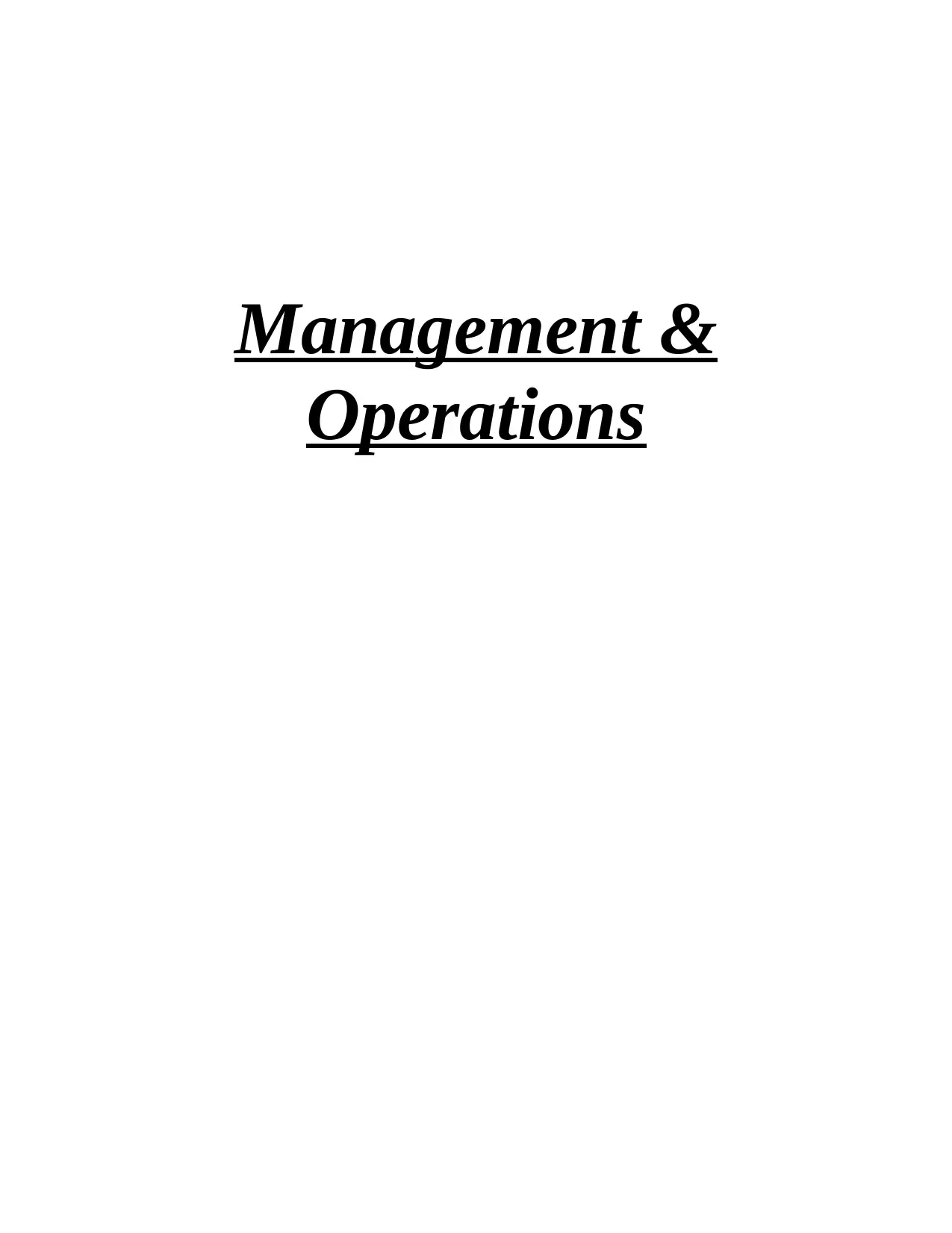
Management &
Operations
Operations
Paraphrase This Document
Need a fresh take? Get an instant paraphrase of this document with our AI Paraphraser
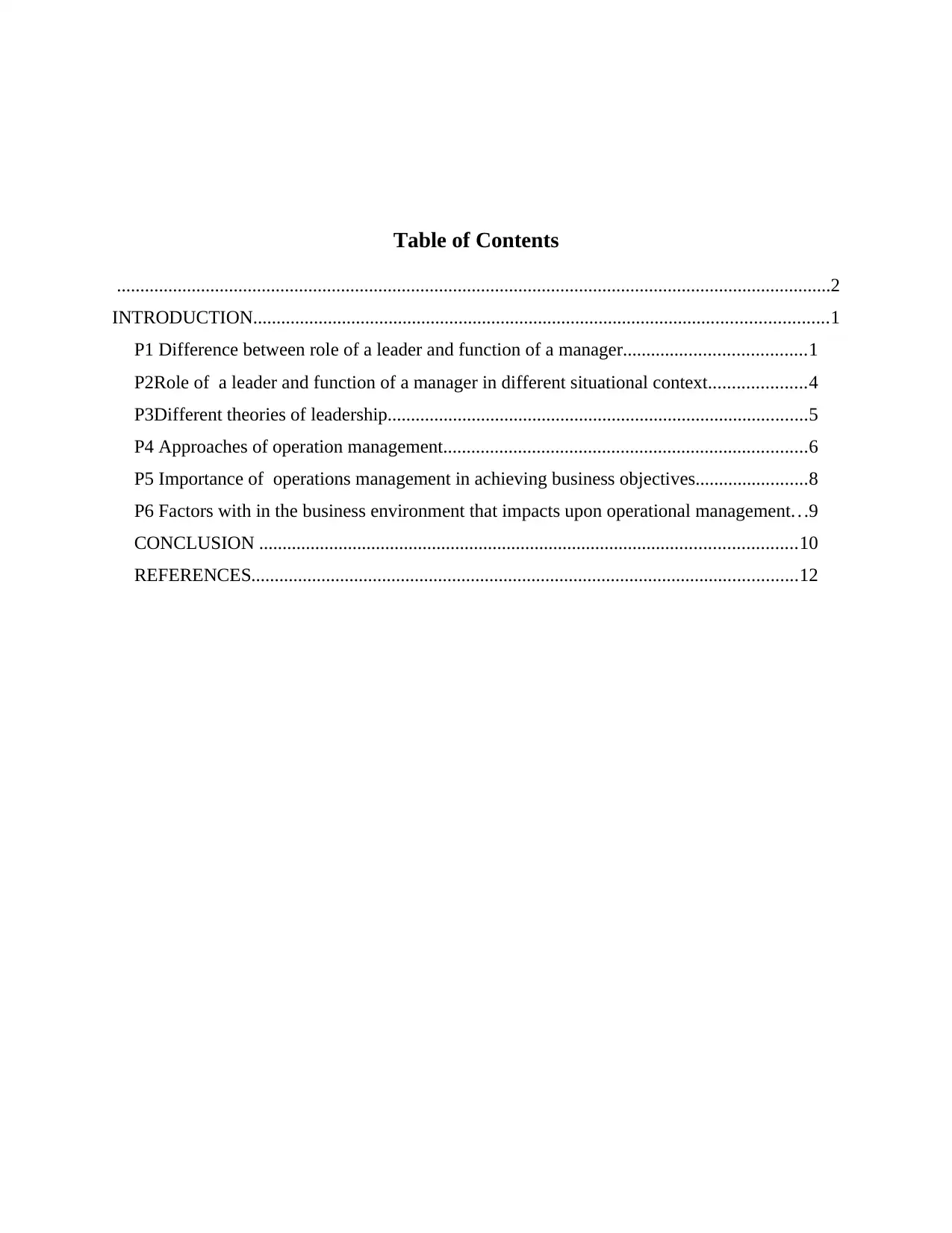
Table of Contents
.........................................................................................................................................................2
INTRODUCTION...........................................................................................................................1
P1 Difference between role of a leader and function of a manager.......................................1
P2Role of a leader and function of a manager in different situational context.....................4
P3Different theories of leadership..........................................................................................5
P4 Approaches of operation management..............................................................................6
P5 Importance of operations management in achieving business objectives........................8
P6 Factors with in the business environment that impacts upon operational management.. .9
CONCLUSION ...................................................................................................................10
REFERENCES.....................................................................................................................12
.........................................................................................................................................................2
INTRODUCTION...........................................................................................................................1
P1 Difference between role of a leader and function of a manager.......................................1
P2Role of a leader and function of a manager in different situational context.....................4
P3Different theories of leadership..........................................................................................5
P4 Approaches of operation management..............................................................................6
P5 Importance of operations management in achieving business objectives........................8
P6 Factors with in the business environment that impacts upon operational management.. .9
CONCLUSION ...................................................................................................................10
REFERENCES.....................................................................................................................12
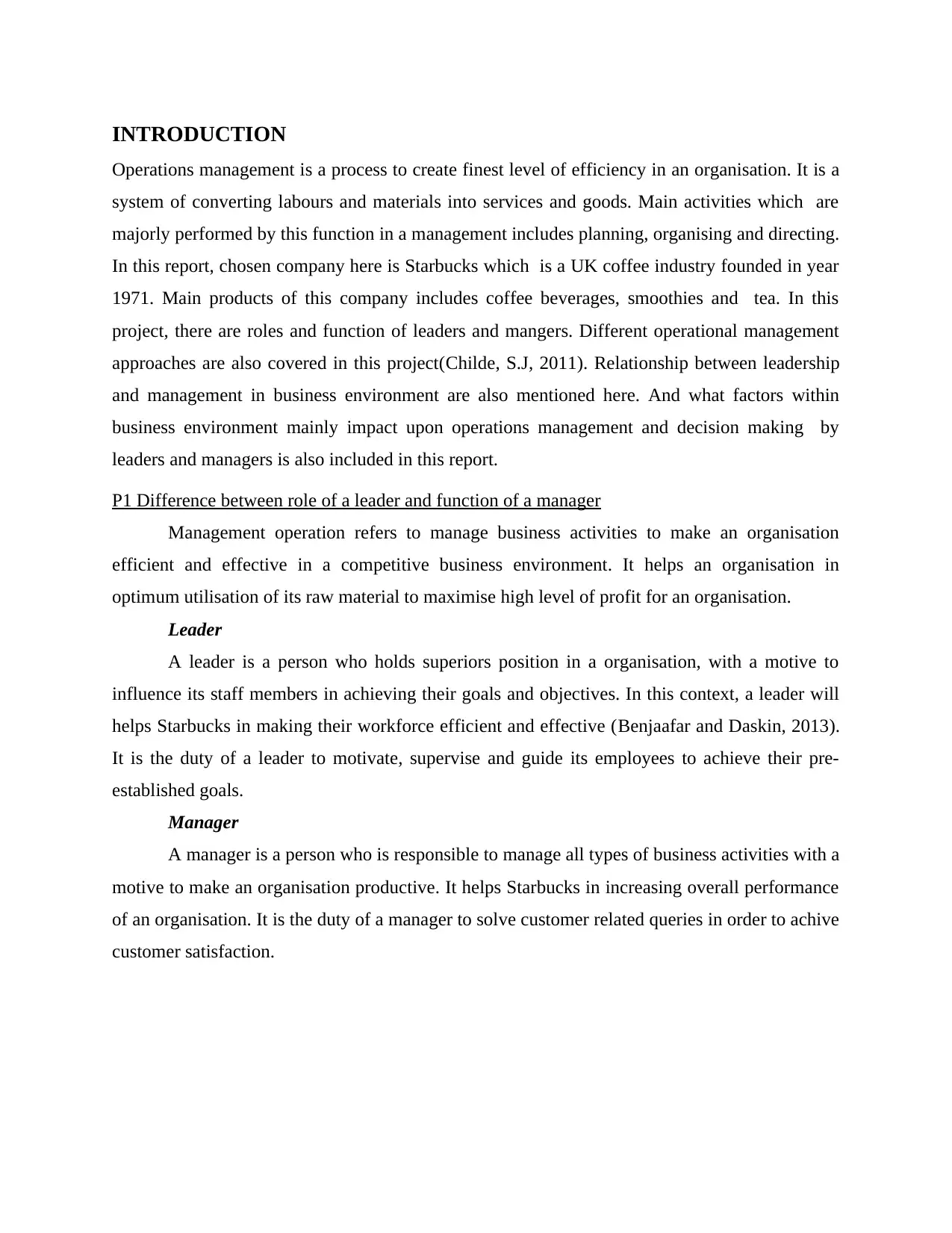
INTRODUCTION
Operations management is a process to create finest level of efficiency in an organisation. It is a
system of converting labours and materials into services and goods. Main activities which are
majorly performed by this function in a management includes planning, organising and directing.
In this report, chosen company here is Starbucks which is a UK coffee industry founded in year
1971. Main products of this company includes coffee beverages, smoothies and tea. In this
project, there are roles and function of leaders and mangers. Different operational management
approaches are also covered in this project(Childe, S.J, 2011). Relationship between leadership
and management in business environment are also mentioned here. And what factors within
business environment mainly impact upon operations management and decision making by
leaders and managers is also included in this report.
P1 Difference between role of a leader and function of a manager
Management operation refers to manage business activities to make an organisation
efficient and effective in a competitive business environment. It helps an organisation in
optimum utilisation of its raw material to maximise high level of profit for an organisation.
Leader
A leader is a person who holds superiors position in a organisation, with a motive to
influence its staff members in achieving their goals and objectives. In this context, a leader will
helps Starbucks in making their workforce efficient and effective (Benjaafar and Daskin, 2013).
It is the duty of a leader to motivate, supervise and guide its employees to achieve their pre-
established goals.
Manager
A manager is a person who is responsible to manage all types of business activities with a
motive to make an organisation productive. It helps Starbucks in increasing overall performance
of an organisation. It is the duty of a manager to solve customer related queries in order to achive
customer satisfaction.
Operations management is a process to create finest level of efficiency in an organisation. It is a
system of converting labours and materials into services and goods. Main activities which are
majorly performed by this function in a management includes planning, organising and directing.
In this report, chosen company here is Starbucks which is a UK coffee industry founded in year
1971. Main products of this company includes coffee beverages, smoothies and tea. In this
project, there are roles and function of leaders and mangers. Different operational management
approaches are also covered in this project(Childe, S.J, 2011). Relationship between leadership
and management in business environment are also mentioned here. And what factors within
business environment mainly impact upon operations management and decision making by
leaders and managers is also included in this report.
P1 Difference between role of a leader and function of a manager
Management operation refers to manage business activities to make an organisation
efficient and effective in a competitive business environment. It helps an organisation in
optimum utilisation of its raw material to maximise high level of profit for an organisation.
Leader
A leader is a person who holds superiors position in a organisation, with a motive to
influence its staff members in achieving their goals and objectives. In this context, a leader will
helps Starbucks in making their workforce efficient and effective (Benjaafar and Daskin, 2013).
It is the duty of a leader to motivate, supervise and guide its employees to achieve their pre-
established goals.
Manager
A manager is a person who is responsible to manage all types of business activities with a
motive to make an organisation productive. It helps Starbucks in increasing overall performance
of an organisation. It is the duty of a manager to solve customer related queries in order to achive
customer satisfaction.
⊘ This is a preview!⊘
Do you want full access?
Subscribe today to unlock all pages.

Trusted by 1+ million students worldwide
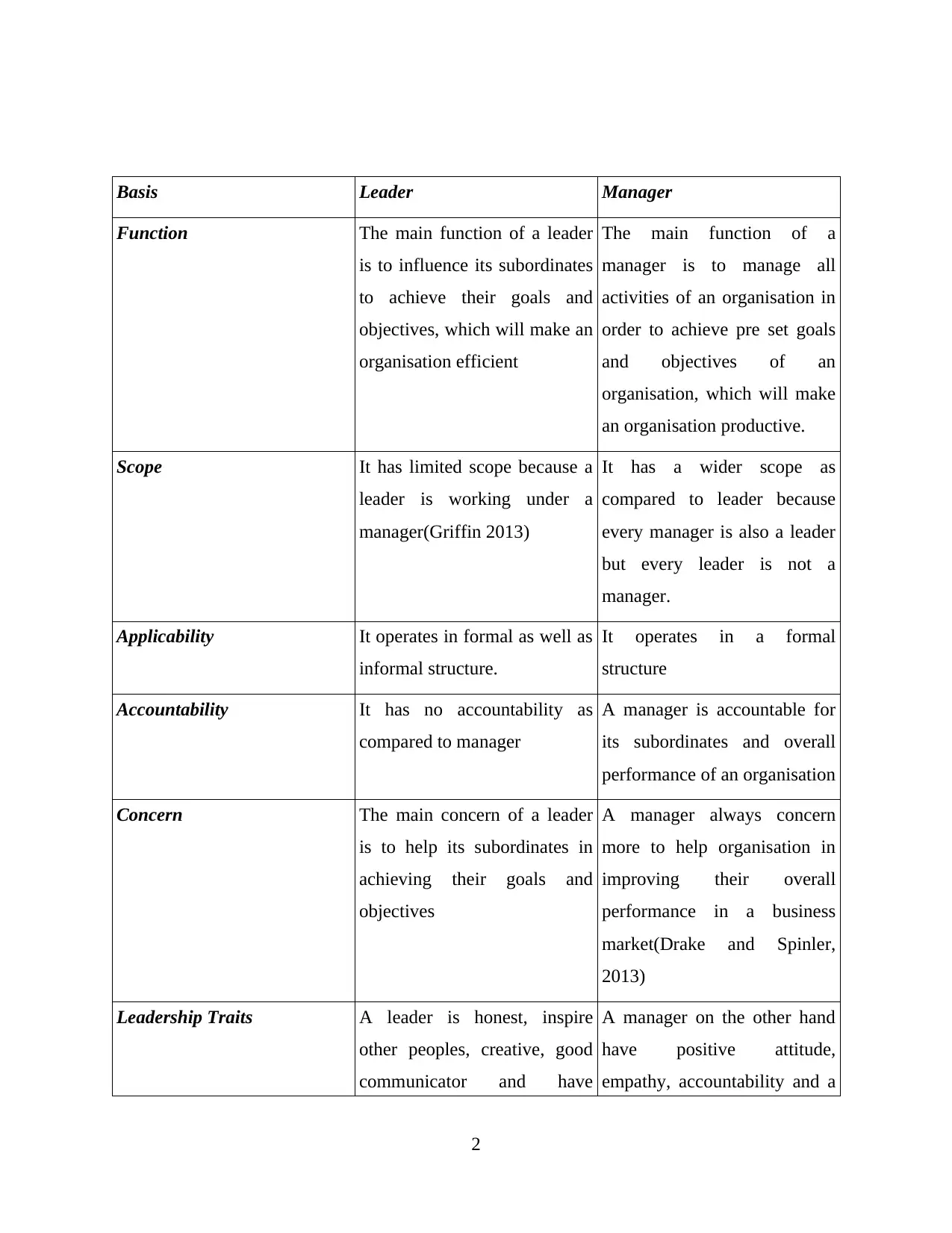
Basis Leader Manager
Function The main function of a leader
is to influence its subordinates
to achieve their goals and
objectives, which will make an
organisation efficient
The main function of a
manager is to manage all
activities of an organisation in
order to achieve pre set goals
and objectives of an
organisation, which will make
an organisation productive.
Scope It has limited scope because a
leader is working under a
manager(Griffin 2013)
It has a wider scope as
compared to leader because
every manager is also a leader
but every leader is not a
manager.
Applicability It operates in formal as well as
informal structure.
It operates in a formal
structure
Accountability It has no accountability as
compared to manager
A manager is accountable for
its subordinates and overall
performance of an organisation
Concern The main concern of a leader
is to help its subordinates in
achieving their goals and
objectives
A manager always concern
more to help organisation in
improving their overall
performance in a business
market(Drake and Spinler,
2013)
Leadership Traits A leader is honest, inspire
other peoples, creative, good
communicator and have
A manager on the other hand
have positive attitude,
empathy, accountability and a
2
Function The main function of a leader
is to influence its subordinates
to achieve their goals and
objectives, which will make an
organisation efficient
The main function of a
manager is to manage all
activities of an organisation in
order to achieve pre set goals
and objectives of an
organisation, which will make
an organisation productive.
Scope It has limited scope because a
leader is working under a
manager(Griffin 2013)
It has a wider scope as
compared to leader because
every manager is also a leader
but every leader is not a
manager.
Applicability It operates in formal as well as
informal structure.
It operates in a formal
structure
Accountability It has no accountability as
compared to manager
A manager is accountable for
its subordinates and overall
performance of an organisation
Concern The main concern of a leader
is to help its subordinates in
achieving their goals and
objectives
A manager always concern
more to help organisation in
improving their overall
performance in a business
market(Drake and Spinler,
2013)
Leadership Traits A leader is honest, inspire
other peoples, creative, good
communicator and have
A manager on the other hand
have positive attitude,
empathy, accountability and a
2
Paraphrase This Document
Need a fresh take? Get an instant paraphrase of this document with our AI Paraphraser
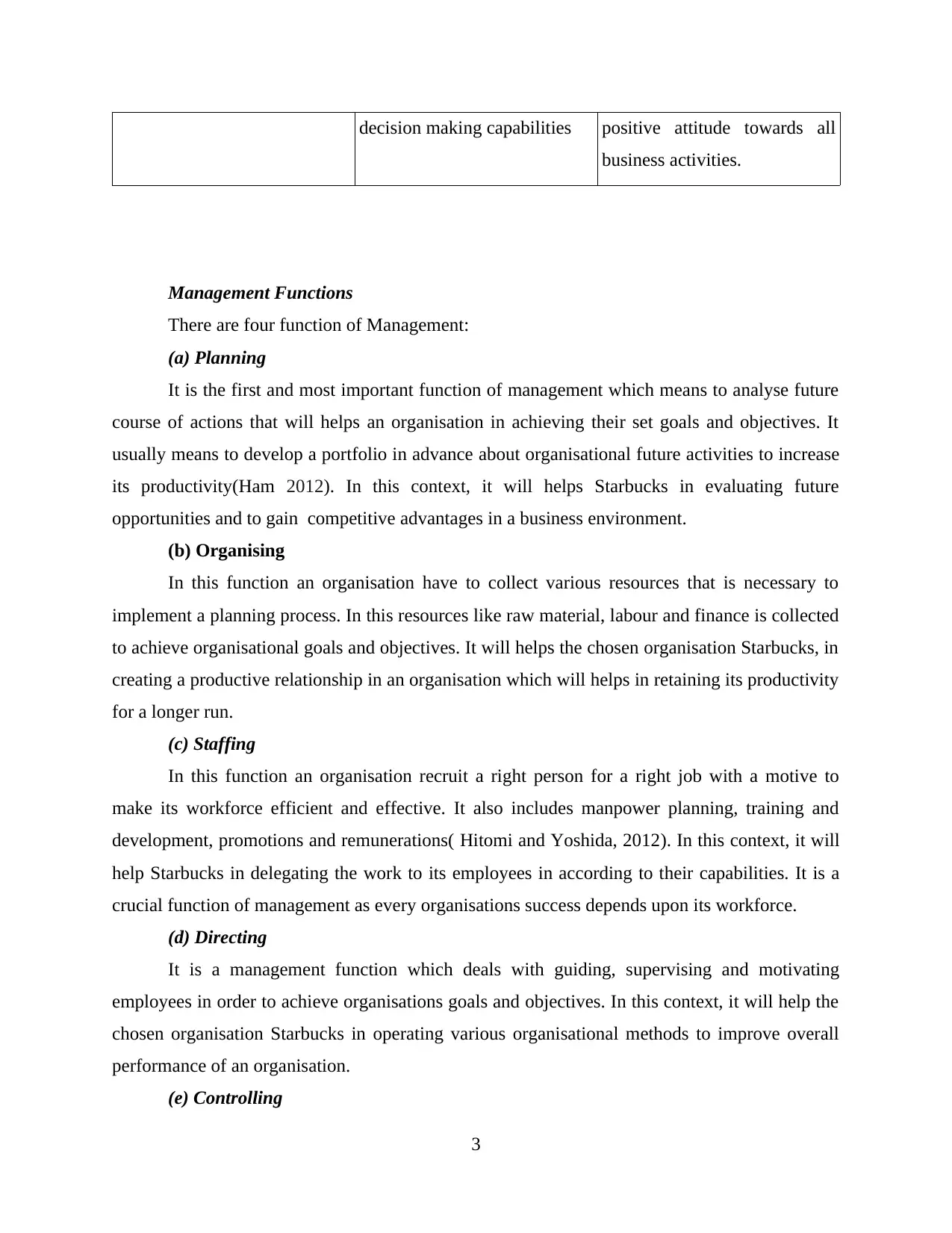
decision making capabilities positive attitude towards all
business activities.
Management Functions
There are four function of Management:
(a) Planning
It is the first and most important function of management which means to analyse future
course of actions that will helps an organisation in achieving their set goals and objectives. It
usually means to develop a portfolio in advance about organisational future activities to increase
its productivity(Ham 2012). In this context, it will helps Starbucks in evaluating future
opportunities and to gain competitive advantages in a business environment.
(b) Organising
In this function an organisation have to collect various resources that is necessary to
implement a planning process. In this resources like raw material, labour and finance is collected
to achieve organisational goals and objectives. It will helps the chosen organisation Starbucks, in
creating a productive relationship in an organisation which will helps in retaining its productivity
for a longer run.
(c) Staffing
In this function an organisation recruit a right person for a right job with a motive to
make its workforce efficient and effective. It also includes manpower planning, training and
development, promotions and remunerations( Hitomi and Yoshida, 2012). In this context, it will
help Starbucks in delegating the work to its employees in according to their capabilities. It is a
crucial function of management as every organisations success depends upon its workforce.
(d) Directing
It is a management function which deals with guiding, supervising and motivating
employees in order to achieve organisations goals and objectives. In this context, it will help the
chosen organisation Starbucks in operating various organisational methods to improve overall
performance of an organisation.
(e) Controlling
3
business activities.
Management Functions
There are four function of Management:
(a) Planning
It is the first and most important function of management which means to analyse future
course of actions that will helps an organisation in achieving their set goals and objectives. It
usually means to develop a portfolio in advance about organisational future activities to increase
its productivity(Ham 2012). In this context, it will helps Starbucks in evaluating future
opportunities and to gain competitive advantages in a business environment.
(b) Organising
In this function an organisation have to collect various resources that is necessary to
implement a planning process. In this resources like raw material, labour and finance is collected
to achieve organisational goals and objectives. It will helps the chosen organisation Starbucks, in
creating a productive relationship in an organisation which will helps in retaining its productivity
for a longer run.
(c) Staffing
In this function an organisation recruit a right person for a right job with a motive to
make its workforce efficient and effective. It also includes manpower planning, training and
development, promotions and remunerations( Hitomi and Yoshida, 2012). In this context, it will
help Starbucks in delegating the work to its employees in according to their capabilities. It is a
crucial function of management as every organisations success depends upon its workforce.
(d) Directing
It is a management function which deals with guiding, supervising and motivating
employees in order to achieve organisations goals and objectives. In this context, it will help the
chosen organisation Starbucks in operating various organisational methods to improve overall
performance of an organisation.
(e) Controlling
3
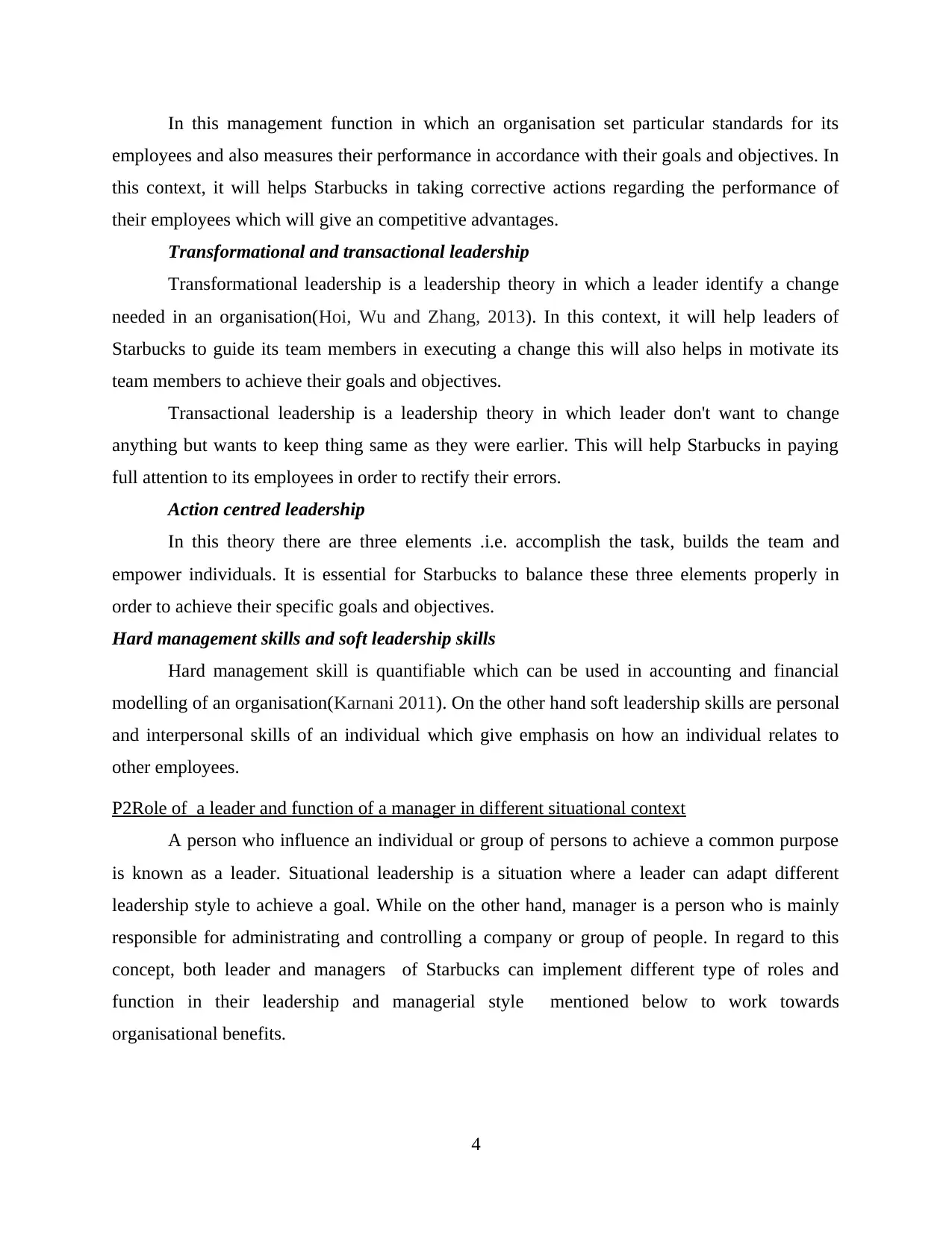
In this management function in which an organisation set particular standards for its
employees and also measures their performance in accordance with their goals and objectives. In
this context, it will helps Starbucks in taking corrective actions regarding the performance of
their employees which will give an competitive advantages.
Transformational and transactional leadership
Transformational leadership is a leadership theory in which a leader identify a change
needed in an organisation(Hoi, Wu and Zhang, 2013). In this context, it will help leaders of
Starbucks to guide its team members in executing a change this will also helps in motivate its
team members to achieve their goals and objectives.
Transactional leadership is a leadership theory in which leader don't want to change
anything but wants to keep thing same as they were earlier. This will help Starbucks in paying
full attention to its employees in order to rectify their errors.
Action centred leadership
In this theory there are three elements .i.e. accomplish the task, builds the team and
empower individuals. It is essential for Starbucks to balance these three elements properly in
order to achieve their specific goals and objectives.
Hard management skills and soft leadership skills
Hard management skill is quantifiable which can be used in accounting and financial
modelling of an organisation(Karnani 2011). On the other hand soft leadership skills are personal
and interpersonal skills of an individual which give emphasis on how an individual relates to
other employees.
P2Role of a leader and function of a manager in different situational context
A person who influence an individual or group of persons to achieve a common purpose
is known as a leader. Situational leadership is a situation where a leader can adapt different
leadership style to achieve a goal. While on the other hand, manager is a person who is mainly
responsible for administrating and controlling a company or group of people. In regard to this
concept, both leader and managers of Starbucks can implement different type of roles and
function in their leadership and managerial style mentioned below to work towards
organisational benefits.
4
employees and also measures their performance in accordance with their goals and objectives. In
this context, it will helps Starbucks in taking corrective actions regarding the performance of
their employees which will give an competitive advantages.
Transformational and transactional leadership
Transformational leadership is a leadership theory in which a leader identify a change
needed in an organisation(Hoi, Wu and Zhang, 2013). In this context, it will help leaders of
Starbucks to guide its team members in executing a change this will also helps in motivate its
team members to achieve their goals and objectives.
Transactional leadership is a leadership theory in which leader don't want to change
anything but wants to keep thing same as they were earlier. This will help Starbucks in paying
full attention to its employees in order to rectify their errors.
Action centred leadership
In this theory there are three elements .i.e. accomplish the task, builds the team and
empower individuals. It is essential for Starbucks to balance these three elements properly in
order to achieve their specific goals and objectives.
Hard management skills and soft leadership skills
Hard management skill is quantifiable which can be used in accounting and financial
modelling of an organisation(Karnani 2011). On the other hand soft leadership skills are personal
and interpersonal skills of an individual which give emphasis on how an individual relates to
other employees.
P2Role of a leader and function of a manager in different situational context
A person who influence an individual or group of persons to achieve a common purpose
is known as a leader. Situational leadership is a situation where a leader can adapt different
leadership style to achieve a goal. While on the other hand, manager is a person who is mainly
responsible for administrating and controlling a company or group of people. In regard to this
concept, both leader and managers of Starbucks can implement different type of roles and
function in their leadership and managerial style mentioned below to work towards
organisational benefits.
4
⊘ This is a preview!⊘
Do you want full access?
Subscribe today to unlock all pages.

Trusted by 1+ million students worldwide
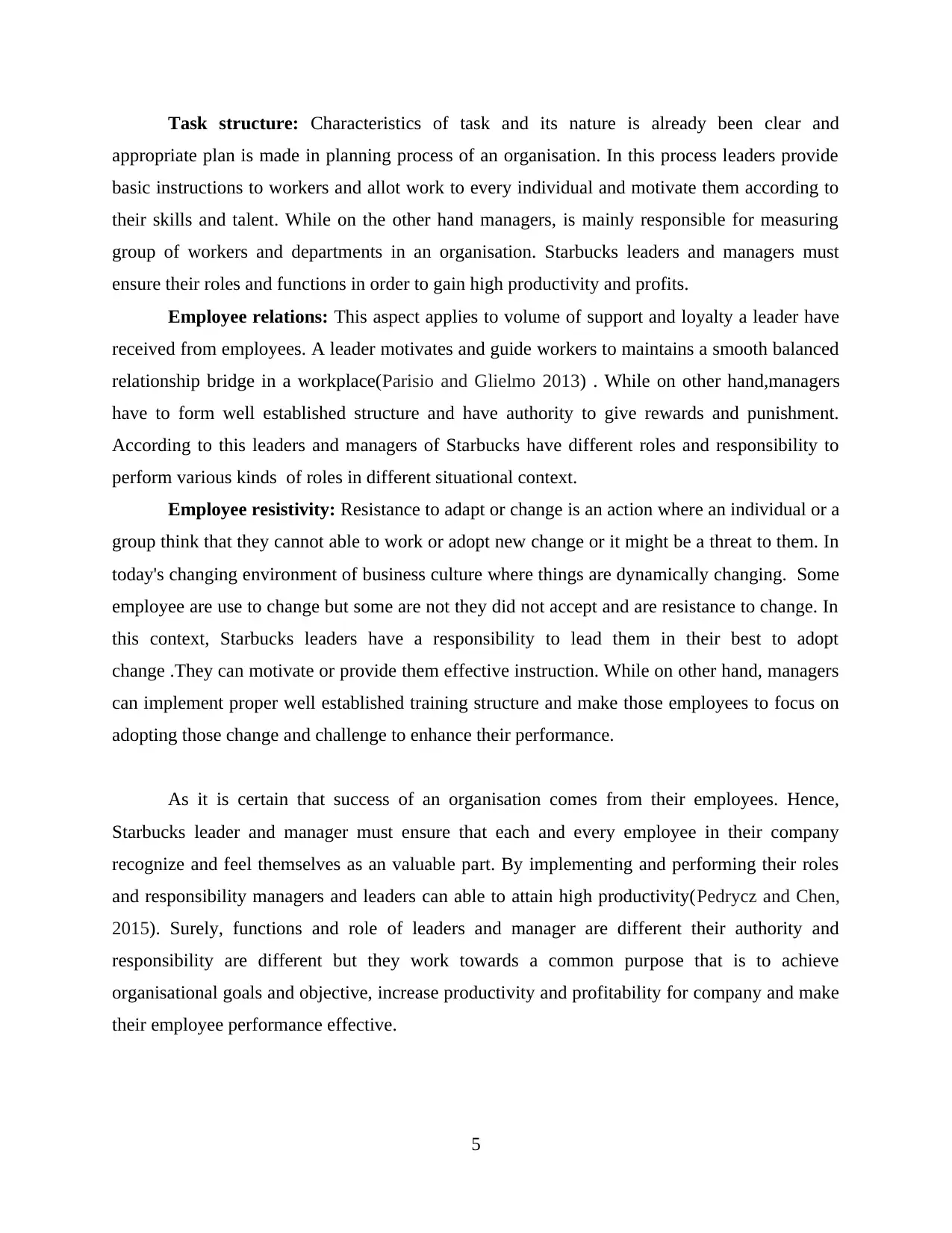
Task structure: Characteristics of task and its nature is already been clear and
appropriate plan is made in planning process of an organisation. In this process leaders provide
basic instructions to workers and allot work to every individual and motivate them according to
their skills and talent. While on the other hand managers, is mainly responsible for measuring
group of workers and departments in an organisation. Starbucks leaders and managers must
ensure their roles and functions in order to gain high productivity and profits.
Employee relations: This aspect applies to volume of support and loyalty a leader have
received from employees. A leader motivates and guide workers to maintains a smooth balanced
relationship bridge in a workplace(Parisio and Glielmo 2013) . While on other hand,managers
have to form well established structure and have authority to give rewards and punishment.
According to this leaders and managers of Starbucks have different roles and responsibility to
perform various kinds of roles in different situational context.
Employee resistivity: Resistance to adapt or change is an action where an individual or a
group think that they cannot able to work or adopt new change or it might be a threat to them. In
today's changing environment of business culture where things are dynamically changing. Some
employee are use to change but some are not they did not accept and are resistance to change. In
this context, Starbucks leaders have a responsibility to lead them in their best to adopt
change .They can motivate or provide them effective instruction. While on other hand, managers
can implement proper well established training structure and make those employees to focus on
adopting those change and challenge to enhance their performance.
As it is certain that success of an organisation comes from their employees. Hence,
Starbucks leader and manager must ensure that each and every employee in their company
recognize and feel themselves as an valuable part. By implementing and performing their roles
and responsibility managers and leaders can able to attain high productivity(Pedrycz and Chen,
2015). Surely, functions and role of leaders and manager are different their authority and
responsibility are different but they work towards a common purpose that is to achieve
organisational goals and objective, increase productivity and profitability for company and make
their employee performance effective.
5
appropriate plan is made in planning process of an organisation. In this process leaders provide
basic instructions to workers and allot work to every individual and motivate them according to
their skills and talent. While on the other hand managers, is mainly responsible for measuring
group of workers and departments in an organisation. Starbucks leaders and managers must
ensure their roles and functions in order to gain high productivity and profits.
Employee relations: This aspect applies to volume of support and loyalty a leader have
received from employees. A leader motivates and guide workers to maintains a smooth balanced
relationship bridge in a workplace(Parisio and Glielmo 2013) . While on other hand,managers
have to form well established structure and have authority to give rewards and punishment.
According to this leaders and managers of Starbucks have different roles and responsibility to
perform various kinds of roles in different situational context.
Employee resistivity: Resistance to adapt or change is an action where an individual or a
group think that they cannot able to work or adopt new change or it might be a threat to them. In
today's changing environment of business culture where things are dynamically changing. Some
employee are use to change but some are not they did not accept and are resistance to change. In
this context, Starbucks leaders have a responsibility to lead them in their best to adopt
change .They can motivate or provide them effective instruction. While on other hand, managers
can implement proper well established training structure and make those employees to focus on
adopting those change and challenge to enhance their performance.
As it is certain that success of an organisation comes from their employees. Hence,
Starbucks leader and manager must ensure that each and every employee in their company
recognize and feel themselves as an valuable part. By implementing and performing their roles
and responsibility managers and leaders can able to attain high productivity(Pedrycz and Chen,
2015). Surely, functions and role of leaders and manager are different their authority and
responsibility are different but they work towards a common purpose that is to achieve
organisational goals and objective, increase productivity and profitability for company and make
their employee performance effective.
5
Paraphrase This Document
Need a fresh take? Get an instant paraphrase of this document with our AI Paraphraser
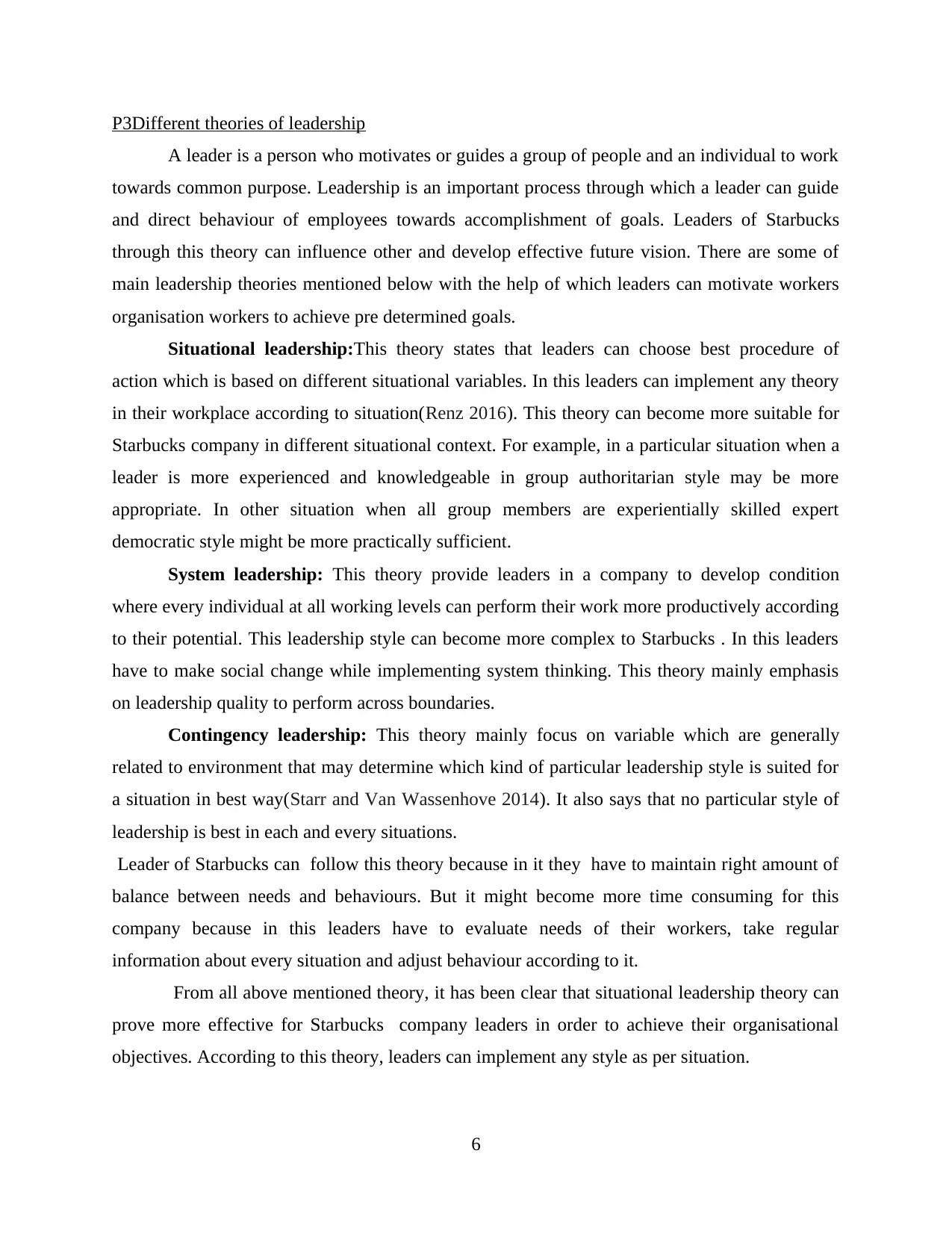
P3Different theories of leadership
A leader is a person who motivates or guides a group of people and an individual to work
towards common purpose. Leadership is an important process through which a leader can guide
and direct behaviour of employees towards accomplishment of goals. Leaders of Starbucks
through this theory can influence other and develop effective future vision. There are some of
main leadership theories mentioned below with the help of which leaders can motivate workers
organisation workers to achieve pre determined goals.
Situational leadership:This theory states that leaders can choose best procedure of
action which is based on different situational variables. In this leaders can implement any theory
in their workplace according to situation(Renz 2016). This theory can become more suitable for
Starbucks company in different situational context. For example, in a particular situation when a
leader is more experienced and knowledgeable in group authoritarian style may be more
appropriate. In other situation when all group members are experientially skilled expert
democratic style might be more practically sufficient.
System leadership: This theory provide leaders in a company to develop condition
where every individual at all working levels can perform their work more productively according
to their potential. This leadership style can become more complex to Starbucks . In this leaders
have to make social change while implementing system thinking. This theory mainly emphasis
on leadership quality to perform across boundaries.
Contingency leadership: This theory mainly focus on variable which are generally
related to environment that may determine which kind of particular leadership style is suited for
a situation in best way(Starr and Van Wassenhove 2014). It also says that no particular style of
leadership is best in each and every situations.
Leader of Starbucks can follow this theory because in it they have to maintain right amount of
balance between needs and behaviours. But it might become more time consuming for this
company because in this leaders have to evaluate needs of their workers, take regular
information about every situation and adjust behaviour according to it.
From all above mentioned theory, it has been clear that situational leadership theory can
prove more effective for Starbucks company leaders in order to achieve their organisational
objectives. According to this theory, leaders can implement any style as per situation.
6
A leader is a person who motivates or guides a group of people and an individual to work
towards common purpose. Leadership is an important process through which a leader can guide
and direct behaviour of employees towards accomplishment of goals. Leaders of Starbucks
through this theory can influence other and develop effective future vision. There are some of
main leadership theories mentioned below with the help of which leaders can motivate workers
organisation workers to achieve pre determined goals.
Situational leadership:This theory states that leaders can choose best procedure of
action which is based on different situational variables. In this leaders can implement any theory
in their workplace according to situation(Renz 2016). This theory can become more suitable for
Starbucks company in different situational context. For example, in a particular situation when a
leader is more experienced and knowledgeable in group authoritarian style may be more
appropriate. In other situation when all group members are experientially skilled expert
democratic style might be more practically sufficient.
System leadership: This theory provide leaders in a company to develop condition
where every individual at all working levels can perform their work more productively according
to their potential. This leadership style can become more complex to Starbucks . In this leaders
have to make social change while implementing system thinking. This theory mainly emphasis
on leadership quality to perform across boundaries.
Contingency leadership: This theory mainly focus on variable which are generally
related to environment that may determine which kind of particular leadership style is suited for
a situation in best way(Starr and Van Wassenhove 2014). It also says that no particular style of
leadership is best in each and every situations.
Leader of Starbucks can follow this theory because in it they have to maintain right amount of
balance between needs and behaviours. But it might become more time consuming for this
company because in this leaders have to evaluate needs of their workers, take regular
information about every situation and adjust behaviour according to it.
From all above mentioned theory, it has been clear that situational leadership theory can
prove more effective for Starbucks company leaders in order to achieve their organisational
objectives. According to this theory, leaders can implement any style as per situation.
6
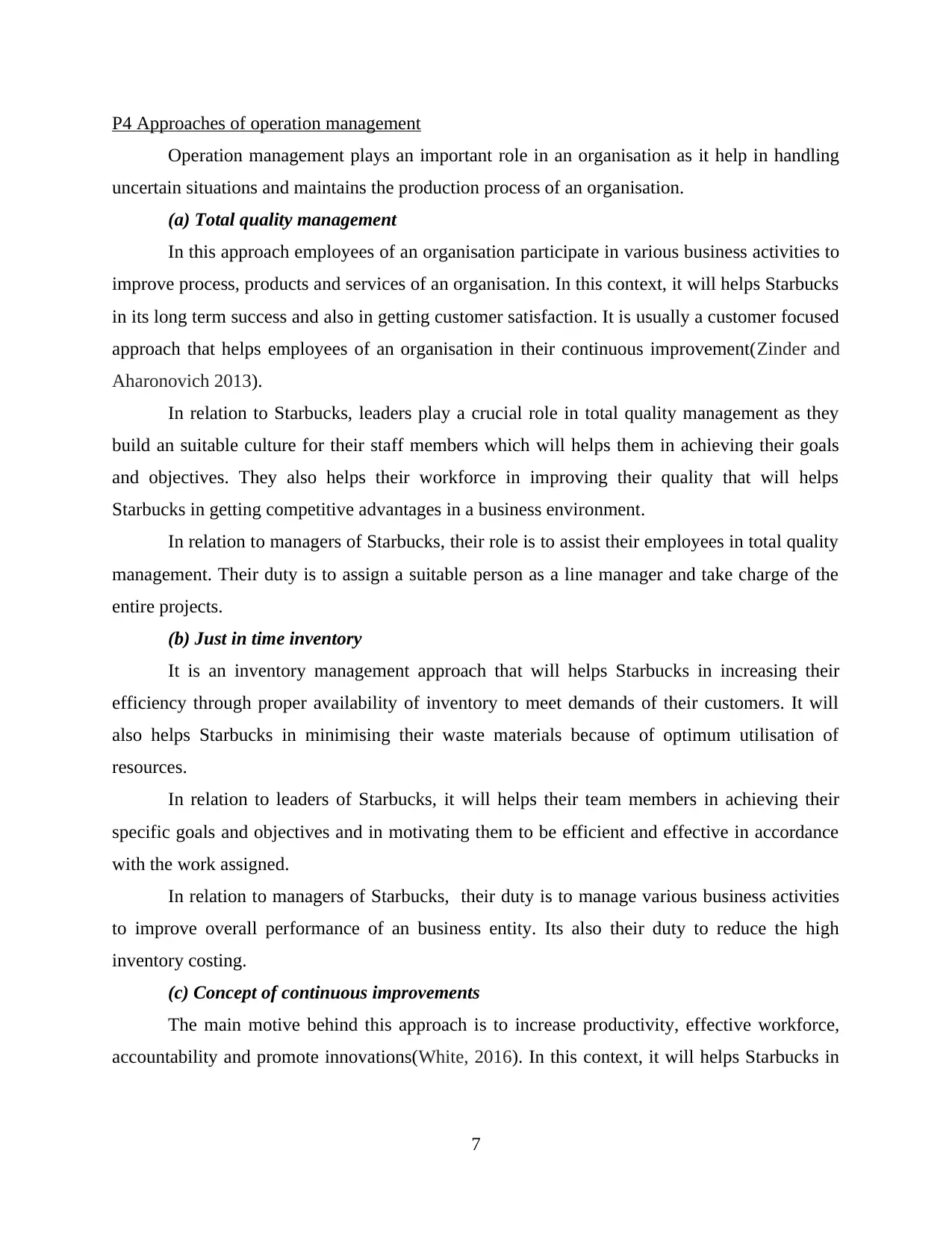
P4 Approaches of operation management
Operation management plays an important role in an organisation as it help in handling
uncertain situations and maintains the production process of an organisation.
(a) Total quality management
In this approach employees of an organisation participate in various business activities to
improve process, products and services of an organisation. In this context, it will helps Starbucks
in its long term success and also in getting customer satisfaction. It is usually a customer focused
approach that helps employees of an organisation in their continuous improvement(Zinder and
Aharonovich 2013).
In relation to Starbucks, leaders play a crucial role in total quality management as they
build an suitable culture for their staff members which will helps them in achieving their goals
and objectives. They also helps their workforce in improving their quality that will helps
Starbucks in getting competitive advantages in a business environment.
In relation to managers of Starbucks, their role is to assist their employees in total quality
management. Their duty is to assign a suitable person as a line manager and take charge of the
entire projects.
(b) Just in time inventory
It is an inventory management approach that will helps Starbucks in increasing their
efficiency through proper availability of inventory to meet demands of their customers. It will
also helps Starbucks in minimising their waste materials because of optimum utilisation of
resources.
In relation to leaders of Starbucks, it will helps their team members in achieving their
specific goals and objectives and in motivating them to be efficient and effective in accordance
with the work assigned.
In relation to managers of Starbucks, their duty is to manage various business activities
to improve overall performance of an business entity. Its also their duty to reduce the high
inventory costing.
(c) Concept of continuous improvements
The main motive behind this approach is to increase productivity, effective workforce,
accountability and promote innovations(White, 2016). In this context, it will helps Starbucks in
7
Operation management plays an important role in an organisation as it help in handling
uncertain situations and maintains the production process of an organisation.
(a) Total quality management
In this approach employees of an organisation participate in various business activities to
improve process, products and services of an organisation. In this context, it will helps Starbucks
in its long term success and also in getting customer satisfaction. It is usually a customer focused
approach that helps employees of an organisation in their continuous improvement(Zinder and
Aharonovich 2013).
In relation to Starbucks, leaders play a crucial role in total quality management as they
build an suitable culture for their staff members which will helps them in achieving their goals
and objectives. They also helps their workforce in improving their quality that will helps
Starbucks in getting competitive advantages in a business environment.
In relation to managers of Starbucks, their role is to assist their employees in total quality
management. Their duty is to assign a suitable person as a line manager and take charge of the
entire projects.
(b) Just in time inventory
It is an inventory management approach that will helps Starbucks in increasing their
efficiency through proper availability of inventory to meet demands of their customers. It will
also helps Starbucks in minimising their waste materials because of optimum utilisation of
resources.
In relation to leaders of Starbucks, it will helps their team members in achieving their
specific goals and objectives and in motivating them to be efficient and effective in accordance
with the work assigned.
In relation to managers of Starbucks, their duty is to manage various business activities
to improve overall performance of an business entity. Its also their duty to reduce the high
inventory costing.
(c) Concept of continuous improvements
The main motive behind this approach is to increase productivity, effective workforce,
accountability and promote innovations(White, 2016). In this context, it will helps Starbucks in
7
⊘ This is a preview!⊘
Do you want full access?
Subscribe today to unlock all pages.

Trusted by 1+ million students worldwide
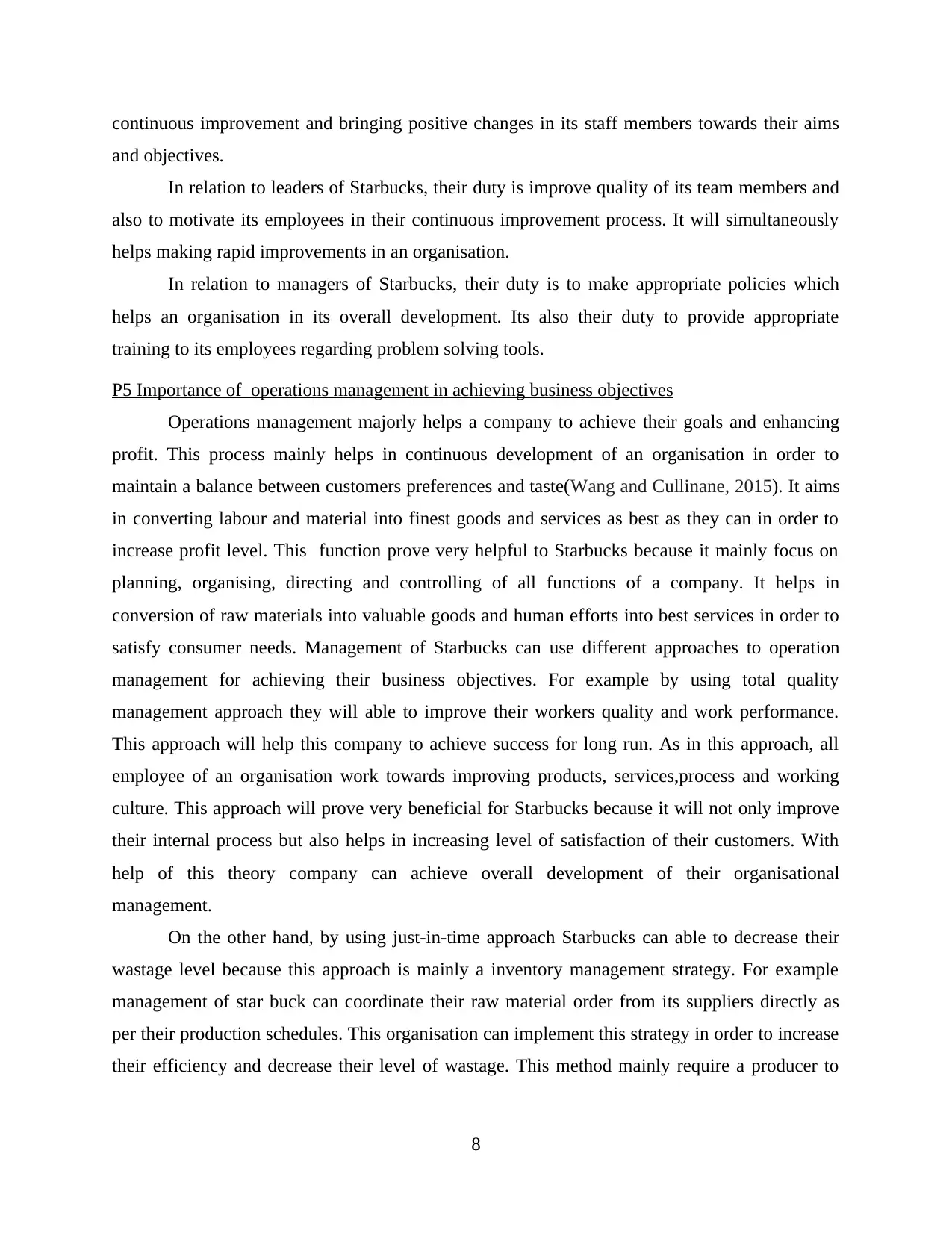
continuous improvement and bringing positive changes in its staff members towards their aims
and objectives.
In relation to leaders of Starbucks, their duty is improve quality of its team members and
also to motivate its employees in their continuous improvement process. It will simultaneously
helps making rapid improvements in an organisation.
In relation to managers of Starbucks, their duty is to make appropriate policies which
helps an organisation in its overall development. Its also their duty to provide appropriate
training to its employees regarding problem solving tools.
P5 Importance of operations management in achieving business objectives
Operations management majorly helps a company to achieve their goals and enhancing
profit. This process mainly helps in continuous development of an organisation in order to
maintain a balance between customers preferences and taste(Wang and Cullinane, 2015). It aims
in converting labour and material into finest goods and services as best as they can in order to
increase profit level. This function prove very helpful to Starbucks because it mainly focus on
planning, organising, directing and controlling of all functions of a company. It helps in
conversion of raw materials into valuable goods and human efforts into best services in order to
satisfy consumer needs. Management of Starbucks can use different approaches to operation
management for achieving their business objectives. For example by using total quality
management approach they will able to improve their workers quality and work performance.
This approach will help this company to achieve success for long run. As in this approach, all
employee of an organisation work towards improving products, services,process and working
culture. This approach will prove very beneficial for Starbucks because it will not only improve
their internal process but also helps in increasing level of satisfaction of their customers. With
help of this theory company can achieve overall development of their organisational
management.
On the other hand, by using just-in-time approach Starbucks can able to decrease their
wastage level because this approach is mainly a inventory management strategy. For example
management of star buck can coordinate their raw material order from its suppliers directly as
per their production schedules. This organisation can implement this strategy in order to increase
their efficiency and decrease their level of wastage. This method mainly require a producer to
8
and objectives.
In relation to leaders of Starbucks, their duty is improve quality of its team members and
also to motivate its employees in their continuous improvement process. It will simultaneously
helps making rapid improvements in an organisation.
In relation to managers of Starbucks, their duty is to make appropriate policies which
helps an organisation in its overall development. Its also their duty to provide appropriate
training to its employees regarding problem solving tools.
P5 Importance of operations management in achieving business objectives
Operations management majorly helps a company to achieve their goals and enhancing
profit. This process mainly helps in continuous development of an organisation in order to
maintain a balance between customers preferences and taste(Wang and Cullinane, 2015). It aims
in converting labour and material into finest goods and services as best as they can in order to
increase profit level. This function prove very helpful to Starbucks because it mainly focus on
planning, organising, directing and controlling of all functions of a company. It helps in
conversion of raw materials into valuable goods and human efforts into best services in order to
satisfy consumer needs. Management of Starbucks can use different approaches to operation
management for achieving their business objectives. For example by using total quality
management approach they will able to improve their workers quality and work performance.
This approach will help this company to achieve success for long run. As in this approach, all
employee of an organisation work towards improving products, services,process and working
culture. This approach will prove very beneficial for Starbucks because it will not only improve
their internal process but also helps in increasing level of satisfaction of their customers. With
help of this theory company can achieve overall development of their organisational
management.
On the other hand, by using just-in-time approach Starbucks can able to decrease their
wastage level because this approach is mainly a inventory management strategy. For example
management of star buck can coordinate their raw material order from its suppliers directly as
per their production schedules. This organisation can implement this strategy in order to increase
their efficiency and decrease their level of wastage. This method mainly require a producer to
8
Paraphrase This Document
Need a fresh take? Get an instant paraphrase of this document with our AI Paraphraser
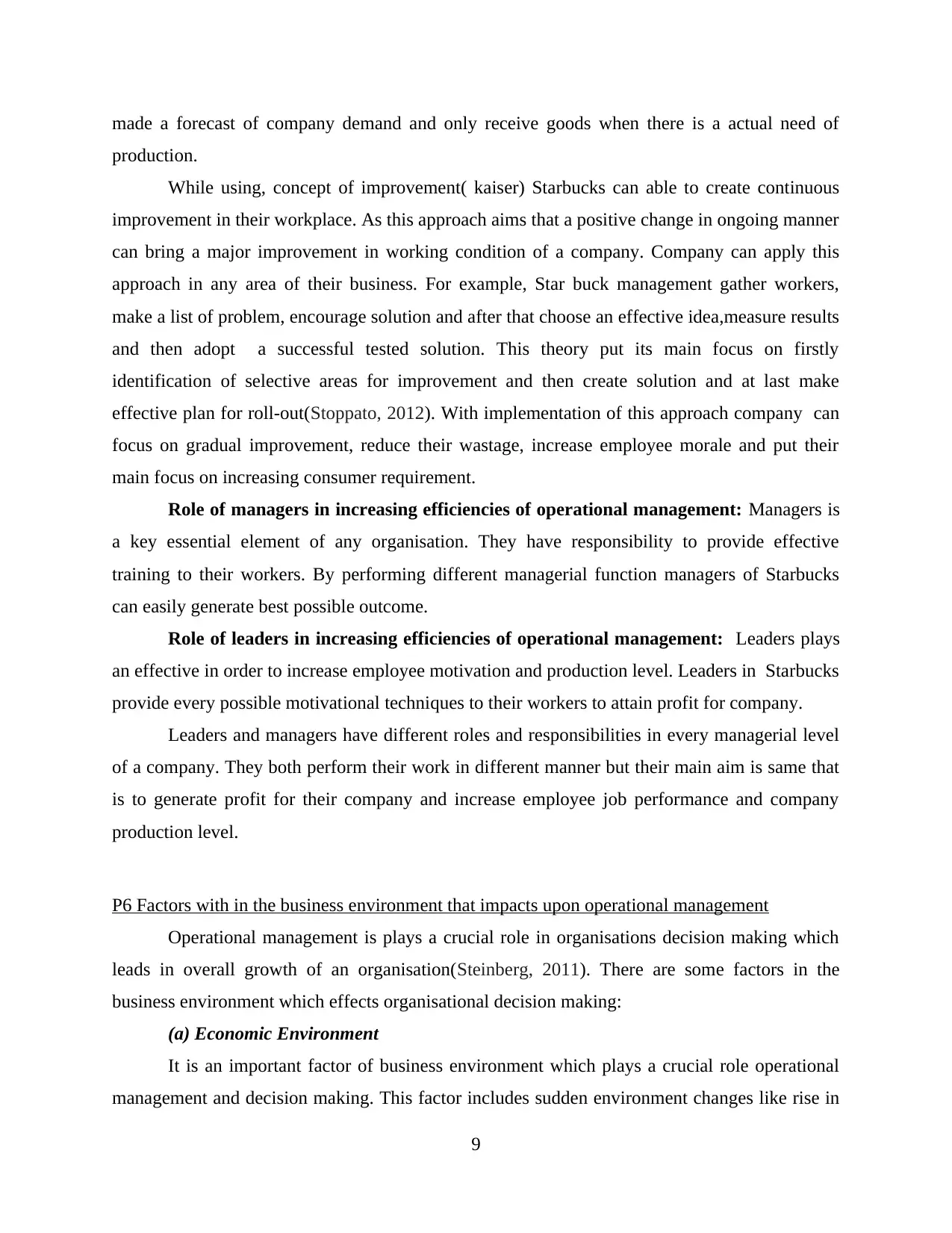
made a forecast of company demand and only receive goods when there is a actual need of
production.
While using, concept of improvement( kaiser) Starbucks can able to create continuous
improvement in their workplace. As this approach aims that a positive change in ongoing manner
can bring a major improvement in working condition of a company. Company can apply this
approach in any area of their business. For example, Star buck management gather workers,
make a list of problem, encourage solution and after that choose an effective idea,measure results
and then adopt a successful tested solution. This theory put its main focus on firstly
identification of selective areas for improvement and then create solution and at last make
effective plan for roll-out(Stoppato, 2012). With implementation of this approach company can
focus on gradual improvement, reduce their wastage, increase employee morale and put their
main focus on increasing consumer requirement.
Role of managers in increasing efficiencies of operational management: Managers is
a key essential element of any organisation. They have responsibility to provide effective
training to their workers. By performing different managerial function managers of Starbucks
can easily generate best possible outcome.
Role of leaders in increasing efficiencies of operational management: Leaders plays
an effective in order to increase employee motivation and production level. Leaders in Starbucks
provide every possible motivational techniques to their workers to attain profit for company.
Leaders and managers have different roles and responsibilities in every managerial level
of a company. They both perform their work in different manner but their main aim is same that
is to generate profit for their company and increase employee job performance and company
production level.
P6 Factors with in the business environment that impacts upon operational management
Operational management is plays a crucial role in organisations decision making which
leads in overall growth of an organisation(Steinberg, 2011). There are some factors in the
business environment which effects organisational decision making:
(a) Economic Environment
It is an important factor of business environment which plays a crucial role operational
management and decision making. This factor includes sudden environment changes like rise in
9
production.
While using, concept of improvement( kaiser) Starbucks can able to create continuous
improvement in their workplace. As this approach aims that a positive change in ongoing manner
can bring a major improvement in working condition of a company. Company can apply this
approach in any area of their business. For example, Star buck management gather workers,
make a list of problem, encourage solution and after that choose an effective idea,measure results
and then adopt a successful tested solution. This theory put its main focus on firstly
identification of selective areas for improvement and then create solution and at last make
effective plan for roll-out(Stoppato, 2012). With implementation of this approach company can
focus on gradual improvement, reduce their wastage, increase employee morale and put their
main focus on increasing consumer requirement.
Role of managers in increasing efficiencies of operational management: Managers is
a key essential element of any organisation. They have responsibility to provide effective
training to their workers. By performing different managerial function managers of Starbucks
can easily generate best possible outcome.
Role of leaders in increasing efficiencies of operational management: Leaders plays
an effective in order to increase employee motivation and production level. Leaders in Starbucks
provide every possible motivational techniques to their workers to attain profit for company.
Leaders and managers have different roles and responsibilities in every managerial level
of a company. They both perform their work in different manner but their main aim is same that
is to generate profit for their company and increase employee job performance and company
production level.
P6 Factors with in the business environment that impacts upon operational management
Operational management is plays a crucial role in organisations decision making which
leads in overall growth of an organisation(Steinberg, 2011). There are some factors in the
business environment which effects organisational decision making:
(a) Economic Environment
It is an important factor of business environment which plays a crucial role operational
management and decision making. This factor includes sudden environment changes like rise in
9
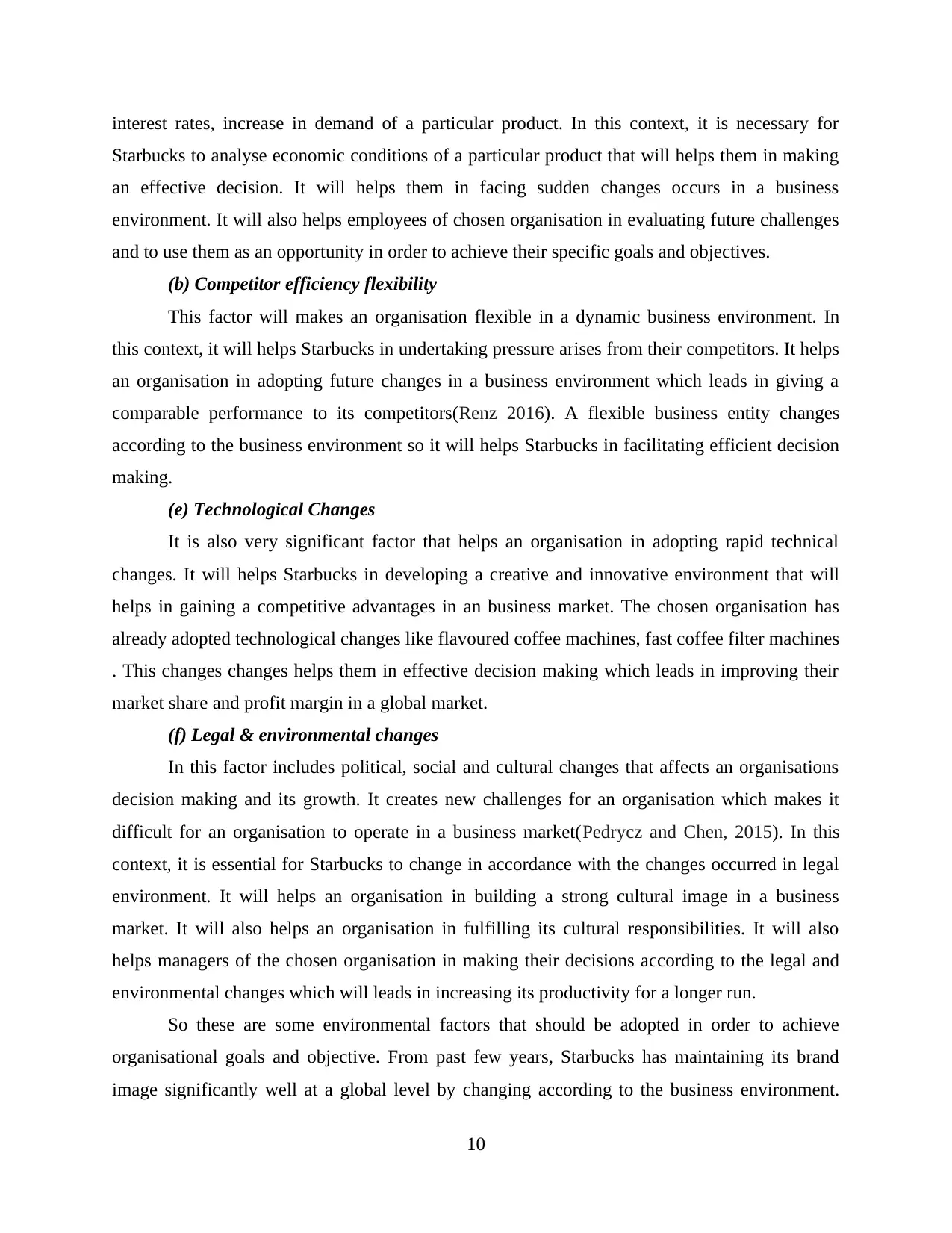
interest rates, increase in demand of a particular product. In this context, it is necessary for
Starbucks to analyse economic conditions of a particular product that will helps them in making
an effective decision. It will helps them in facing sudden changes occurs in a business
environment. It will also helps employees of chosen organisation in evaluating future challenges
and to use them as an opportunity in order to achieve their specific goals and objectives.
(b) Competitor efficiency flexibility
This factor will makes an organisation flexible in a dynamic business environment. In
this context, it will helps Starbucks in undertaking pressure arises from their competitors. It helps
an organisation in adopting future changes in a business environment which leads in giving a
comparable performance to its competitors(Renz 2016). A flexible business entity changes
according to the business environment so it will helps Starbucks in facilitating efficient decision
making.
(e) Technological Changes
It is also very significant factor that helps an organisation in adopting rapid technical
changes. It will helps Starbucks in developing a creative and innovative environment that will
helps in gaining a competitive advantages in an business market. The chosen organisation has
already adopted technological changes like flavoured coffee machines, fast coffee filter machines
. This changes changes helps them in effective decision making which leads in improving their
market share and profit margin in a global market.
(f) Legal & environmental changes
In this factor includes political, social and cultural changes that affects an organisations
decision making and its growth. It creates new challenges for an organisation which makes it
difficult for an organisation to operate in a business market(Pedrycz and Chen, 2015). In this
context, it is essential for Starbucks to change in accordance with the changes occurred in legal
environment. It will helps an organisation in building a strong cultural image in a business
market. It will also helps an organisation in fulfilling its cultural responsibilities. It will also
helps managers of the chosen organisation in making their decisions according to the legal and
environmental changes which will leads in increasing its productivity for a longer run.
So these are some environmental factors that should be adopted in order to achieve
organisational goals and objective. From past few years, Starbucks has maintaining its brand
image significantly well at a global level by changing according to the business environment.
10
Starbucks to analyse economic conditions of a particular product that will helps them in making
an effective decision. It will helps them in facing sudden changes occurs in a business
environment. It will also helps employees of chosen organisation in evaluating future challenges
and to use them as an opportunity in order to achieve their specific goals and objectives.
(b) Competitor efficiency flexibility
This factor will makes an organisation flexible in a dynamic business environment. In
this context, it will helps Starbucks in undertaking pressure arises from their competitors. It helps
an organisation in adopting future changes in a business environment which leads in giving a
comparable performance to its competitors(Renz 2016). A flexible business entity changes
according to the business environment so it will helps Starbucks in facilitating efficient decision
making.
(e) Technological Changes
It is also very significant factor that helps an organisation in adopting rapid technical
changes. It will helps Starbucks in developing a creative and innovative environment that will
helps in gaining a competitive advantages in an business market. The chosen organisation has
already adopted technological changes like flavoured coffee machines, fast coffee filter machines
. This changes changes helps them in effective decision making which leads in improving their
market share and profit margin in a global market.
(f) Legal & environmental changes
In this factor includes political, social and cultural changes that affects an organisations
decision making and its growth. It creates new challenges for an organisation which makes it
difficult for an organisation to operate in a business market(Pedrycz and Chen, 2015). In this
context, it is essential for Starbucks to change in accordance with the changes occurred in legal
environment. It will helps an organisation in building a strong cultural image in a business
market. It will also helps an organisation in fulfilling its cultural responsibilities. It will also
helps managers of the chosen organisation in making their decisions according to the legal and
environmental changes which will leads in increasing its productivity for a longer run.
So these are some environmental factors that should be adopted in order to achieve
organisational goals and objective. From past few years, Starbucks has maintaining its brand
image significantly well at a global level by changing according to the business environment.
10
⊘ This is a preview!⊘
Do you want full access?
Subscribe today to unlock all pages.

Trusted by 1+ million students worldwide
1 out of 14
Related Documents
Your All-in-One AI-Powered Toolkit for Academic Success.
+13062052269
info@desklib.com
Available 24*7 on WhatsApp / Email
![[object Object]](/_next/static/media/star-bottom.7253800d.svg)
Unlock your academic potential
Copyright © 2020–2025 A2Z Services. All Rights Reserved. Developed and managed by ZUCOL.





